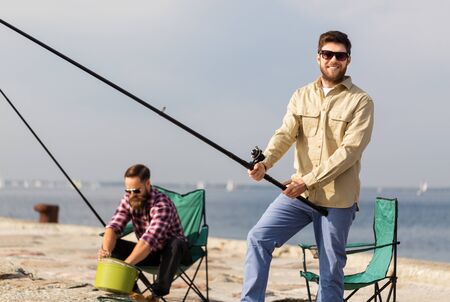1. Understanding Your Spinning Reel Setup
Before you can cast with pinpoint accuracy or reach impressive distances, it’s essential to understand the basics of your spinning reel setup. The way your gear is configured has a direct impact on how well you cast. This includes knowing the key components of your spinning reel, choosing the right line type, selecting an appropriate reel size, and pairing it with the right rod.
Key Components of a Spinning Reel
Your spinning reel is made up of several parts that work together to help you cast smoothly and retrieve efficiently. Here’s a quick breakdown:
| Component | Description |
|---|---|
| Spool | Holds the fishing line; affects how smoothly the line comes off during a cast. |
| Bail | Guides the line onto the spool and helps control line flow during casting and retrieval. |
| Handle | Used to retrieve the line after casting or when reeling in a fish. |
| Drag System | Controls how much resistance a fish feels when pulling on the line. |
| Reel Foot | The part that attaches the reel to your rod. |
Choosing the Right Line Type
The type of fishing line you use can make a big difference in your casting distance and accuracy. Here are the most common types:
| Line Type | Pros | Best For |
|---|---|---|
| Monofilament | Stretchy, forgiving, floats well | Beginners, topwater fishing |
| Braided | No stretch, very strong, small diameter | Long casts, heavy cover situations |
| Fluorocarbon | Low visibility underwater, sinks quickly | Clear water, finesse techniques |
Selecting the Right Reel Size
Spinning reels come in various sizes—from 1000 (small) to 8000+ (large). The right size depends on what youre fishing for and where youre doing it.
| Reel Size Range | Ideal Use Case |
|---|---|
| 1000–2500 | Panfish, trout, light freshwater use |
| 3000–4000 | Bass, walleye, inshore saltwater fishing |
| 5000+ | Larger saltwater species and heavy freshwater setups |
Rod and Reel Pairing Tips
A balanced setup means better casting performance. Match your rods power and action with your reel size and line weight. Here’s a quick guide:
| Rod Power & Action | Recommended Reel Size | Line Weight (lb test) |
|---|---|---|
| Ultralight / Fast Action | 1000–2000 | 2–6 lb test |
| Medium / Moderate Action | 2500–3500 | 6–12 lb test |
| Heavy / Fast Action | 4000+ | 15+ lb test (braid or mono) |
Tuning Your Setup for Better Casting Performance
A properly tuned setup will reduce wind knots, improve line flow, and maximize distance. Make sure your spool is filled correctly—about 1/8 inch from the lip—and check that your rod guides are aligned with the reel spool for smooth casts. Taking time to set everything up right will pay off every time you hit the water.
A good spinning reel setup isn’t just about having quality gear—it’s about making sure every component works together to give you better control and longer casts. Once you’ve nailed down your setup, you’re ready to move on to mastering casting technique itself.
2. The Fundamentals of Casting Technique
Getting the most out of your spinning reel starts with mastering the basics. Whether youre fishing a neighborhood pond or heading out on a weekend lake trip, understanding the core mechanics of casting will help you achieve both accuracy and distance. Let’s break down the essential parts of a solid casting technique — grip, stance, motion, and timing.
Proper Grip: Holding Your Spinning Rod Right
Your grip is the foundation of every cast. Hold the rod handle firmly but not too tight — think handshake-level pressure. Place your index finger against the line where it comes off the spool so you can control its release. Your reel should hang beneath the rod, and your fingers should wrap comfortably around the handle.
Common Grip Mistakes
| Mistake | What Happens |
|---|---|
| Holding too tightly | Reduces wrist movement and casting distance |
| Poor finger placement | Makes timing your release harder and less accurate |
| Reel positioned on top | Affects balance and control during cast |
Your Stance: Balance Equals Control
Your body position matters more than you might think. Stand with your feet shoulder-width apart, knees slightly bent, and weight evenly distributed. For right-handed casters, place your left foot slightly forward for better balance when swinging. This stance keeps you stable and helps transfer energy smoothly from your body into the rod during the cast.
The Casting Motion: Smooth and Controlled
A good casting motion is all about fluidity. Start by opening the bail arm with your free hand while holding the line with your index finger. Bring the rod tip back over your shoulder, then swing it forward in one smooth motion, releasing the line at about the 10 o’clock position. Don’t muscle it — let the rod do the work.
Casting Timing Guide
| Casting Step | Description |
|---|---|
| Bail Open & Line Held | Use index finger to hold line before cast begins |
| Backswing Position | Rod tip at about 2 o’clock behind you |
| Smooth Forward Swing | Aim for 10 o’clock release point in front of you |
| Release Line at Peak Speed | This helps maximize both distance and accuracy |
Tuning In Your Timing for Accuracy & Distance
The secret to an effective cast lies in when you let go of the line. Releasing too early sends your lure high into the air; too late, and it crashes too short or low. With practice, youll learn to feel that perfect moment when the rod loads up and naturally launches your lure forward.
Pro Tip:
If youre just starting out, practice in an open field or park using a casting plug instead of a hook. Focus on landing in a specific target zone to build muscle memory.
Nail these fundamentals first, and youll see immediate improvements in how far and accurately you can cast with a spinning reel.

3. Maximizing Casting Distance
If you’re looking to cast farther with your spinning reel, it’s all about combining the right technique with the proper gear setup. Whether youre targeting fish in wide-open lakes or trying to reach a distant structure, every extra foot counts. Here’s how you can maximize your casting distance while keeping accuracy in check.
Rod Loading: Let the Rod Do the Work
One of the most important elements for long casts is properly loading your rod. This means using the bend of the rod during your cast to store and release energy efficiently. A fast or medium-fast action rod typically works best for this because it flexes primarily near the tip, allowing for a quick snap and better distance.
Quick Tip:
- Use a smooth, controlled motion—don’t muscle your cast.
- Allow the rod to fully load before releasing the line.
Line Management: Reduce Friction and Tangles
Poor line management can kill your casting distance. Make sure your spool is filled properly and that you’re using a line suited for distance casting—braided lines are a favorite among many anglers because they’re thinner and generate less friction.
| Line Type | Pros | Best Use |
|---|---|---|
| Braided Line | Thin diameter, low memory, excellent casting distance | Long-distance casting, open water |
| Monofilament Line | Stretchy, easy to handle | Short-to-medium range, beginners |
| Fluorocarbon Line | Low visibility underwater, more abrasion-resistant | Clear water conditions, finesse techniques |
Casting Motion: Smooth and Straightforward
Your casting form matters just as much as your gear. A smooth overhead cast or sidearm cast with a clean follow-through helps maintain accuracy and lets you reach greater distances. Avoid jerky motions—they reduce rod loading and can send your lure off target.
Steps for an Effective Long-Distance Cast:
- Grip: Hold the rod comfortably with your dominant hand above the reel seat.
- Backswing: Bring the rod back slowly until it reaches about 1 o’clock position.
- Forward Cast: Accelerate forward in one smooth motion while releasing the line at around 10 o’clock.
- Follow Through: Point your rod tip toward where you want the lure to land.
Pro Tip:
Avoid overfilling your reel spool—it should be about 1/8 inch below the rim. Too much line increases friction and causes wind knots or backlash.
By dialing in these key elements—rod loading, smart line selection, and consistent casting form—you’ll not only boost your casting distance but also keep those long casts accurate. Keep practicing and fine-tuning each part of your technique on every trip to see steady improvements.
4. Improving Accuracy in Challenging Conditions
Fishing with a spinning reel isnt always about calm water and perfect weather. Sometimes, youre casting into the wind, dealing with strong currents, or trying to land your lure near tricky cover like submerged logs or dense vegetation. Being able to adjust your casting technique in these conditions can make all the difference between landing fish or going home empty-handed.
Dealing With Wind
Wind can seriously throw off your cast if youre not ready for it. Whether its blowing at your face, back, or side, each situation calls for a different approach:
| Wind Direction | Adjustment Tips |
|---|---|
| Headwind (blowing toward you) | Use a heavier lure for better momentum; lower your casting angle to cut through the wind. |
| Tailwind (blowing behind you) | This helps your cast go farther—use lighter lures and watch your distance control. |
| Crosswind (blowing from the side) | Aim slightly into the wind to compensate for drift; use two hands for better rod control. |
Fishing in Current
Casting in rivers or tidal waters means dealing with current. To stay accurate:
- Cast upstream: This gives your bait more natural movement as it drifts down with the current.
- Use slightly heavier tackle: Helps keep your bait on target instead of being swept away.
- Adjust retrieve speed: Faster current? Retrieve slower to keep your lure in the strike zone longer.
Casting Around Cover
When youre targeting bass around docks, fallen trees, or weed beds, accuracy is key. Heres how to improve:
- Practice pitching and flipping techniques: These short-range casts give you pinpoint control over lure placement.
- Use the right rod length: A shorter rod helps in tight spaces, while a longer one offers reach when casting past obstacles.
- Keep an eye on splashdown: Soft landings reduce spooking fish—feather the line with your finger just before impact.
Tuning Your Gear for Conditions
Your reel setup can also make a big difference. Try these adjustments:
| Condition | Spool Tension & Drag Settings |
|---|---|
| Windy Days | Tighten spool tension slightly to prevent backlash; moderate drag setting helps avoid snap-offs. |
| Heavy Cover | Loosen drag a bit for give when fish run; spool tension should allow quick reactions without overcasting. |
Pro Tip:
If youre struggling with accuracy, try slowing down your cast motion. A smooth, controlled release gives better results than trying to muscle it through tough conditions.
5. Common Mistakes and How to Fix Them
Even seasoned anglers can run into casting issues with a spinning reel. Whether youre aiming for pinpoint accuracy or extra distance, knowing what can go wrong — and how to fix it — is key to improving your performance on the water. Here are some of the most common spinning reel casting mistakes and straightforward ways to correct them.
Line Twist
What Happens: Line twist occurs when the fishing line coils or loops as it comes off the spool, often leading to tangles or reduced casting distance.
Why It Happens: This usually results from reeling against a running drag, spooling line incorrectly, or using lures that spin during retrieval.
How to Fix It:
- Let the line untwist: Remove your lure, let out about 50 feet of line behind a moving boat or while walking along the shore, and let it straighten out naturally before reeling in.
- Use a swivel: Tie a barrel swivel between your main line and lure to reduce twist caused by spinning baits.
- Check your spooling method: Make sure you’re loading new line onto your reel in the same direction it comes off the filler spool.
Backlash (Wind Knots)
What Happens: Backlash or wind knots cause messy tangles in your line as it unspools during a cast, especially in windy conditions.
Why It Happens: Overfilling the spool, using too much force when casting, or not controlling the line with your finger after release can lead to this problem.
How to Fix It:
- Avoid overfilling: Fill your spool only up to about 1/8 inch below the rim.
- Smooth casting motion: Avoid snapping your rod; instead, use a fluid, controlled movement.
- Tension control: Use your index finger to lightly feather the line right after the cast for better control.
Poor Accuracy
What Happens: Your lure lands far from your intended target, making presentations ineffective and potentially spooking fish.
Why It Happens: Poor timing on release, incorrect rod angle, or inconsistent casting technique can all throw off accuracy.
How to Fix It:
- Tune your release point: Practice releasing the line slightly earlier or later to dial in precision.
- Aim with your rod tip: Point your rod at your target throughout the cast and follow through toward it.
- Create muscle memory: Repetition builds consistency—practice with targets on land before hitting the water.
Troubleshooting Summary Table
| Mistake | Main Cause | Quick Fix |
|---|---|---|
| Line Twist | Lure rotation or improper spooling | Add a swivel, let line untwist in water |
| Backlash/Wind Knots | Poor line control or overfilled spool | Smooth cast motion, dont overfill spool |
| Poor Accuracy | Mistimed release or rod misalignment | Aim with rod tip, practice release timing |
Tackling these common mistakes head-on will help you make smoother casts that land exactly where you want them. With just a few tweaks to your technique and gear setup, youll be well on your way to mastering spinning reel casting for both distance and accuracy.


